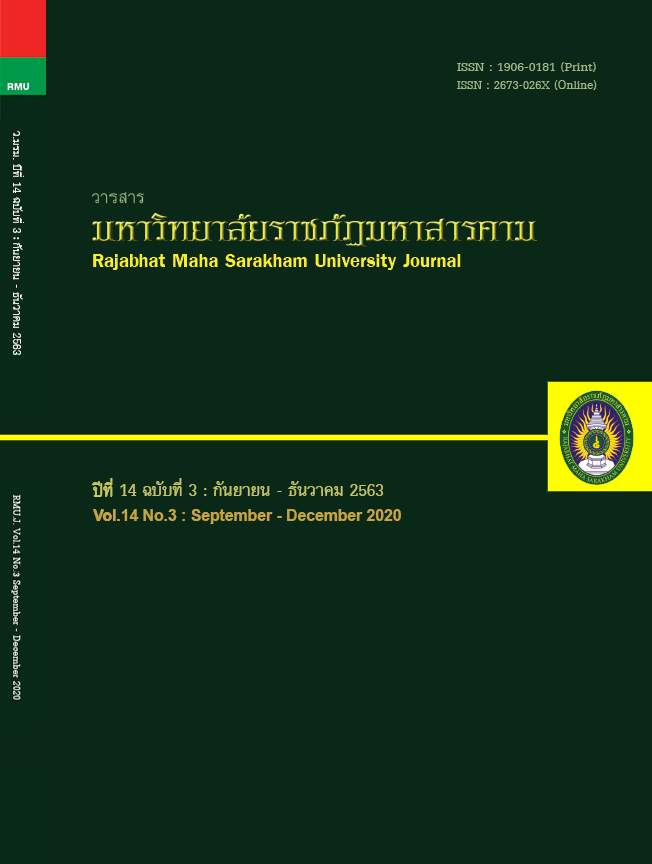การพัฒนาทักษะการฟัง พูดด้วยตนเองผ่าน VRChat สำหรับผู้เรียนภาษาอังกฤษเป็นภาษาต่างประเทศ
Main Article Content
บทคัดย่อ
เทคโนโลยีได้เข้ามามีบทบาทสำคัญต่อการศึกษาในการช่วยส่งเสริมให้ผู้เรียนพัฒนาทักษะด้านต่างๆ และเกิดกระบวนการเรียนรู้ด้วยตนเอง วีอาร์แชท (VRChat)เป็นแอปพลิเคชั่นในรูปแบบสังคมออนไลน์ที่ให้บริการกับผู้ใช้งานโดยไม่เสียค่าใช้จ่ายผู้เรียนภาษาอังกฤษเป็นภาษาต่างประเทศสามารถใช้งานเพื่อสื่อสารกับบุคคลอื่นทั่วโลกผ่านตัวละครอวทาร์ (Avatar) เพื่อพัฒนาทักษะฟังพูดด้วยตนเองนอกห้องเรียน สอดคล้องกับสถานการณ์ในปัจจุบันที่เปลี่ยนวิถีชีวิตของผู้คนไปสู่การใช้ชีวิตแบบความปรกติใหม่หรือฐานชีวิตใหม่ “นิวนอร์มอล” (New Normal)นอกจากประโยชน์ในด้านการฝึกฝนทักษะทางภาษา แอปพลิเคชั่นนี้ยังช่วยให้ผู้เรียนได้เรียนรู้ความแตกต่างทางด้านวัฒนธรรมที่หลากหลายจากการมีปฏิสัมพันธ์กับบุคคลทั่วโลก ช่วยสร้างความมั่นใจในการใช้ภาษาจากการเรียนปนเล่นและเพิ่มแรงจูงใจในการเรียนรู้สิ่งต่าง ๆ รอบตัวได้อีกด้วย ทั้งนี้ผู้เรียนควรต้องศึกษาข้อตกลงและข้อกำหนดต่าง ๆจากแอปพลิเคชั่นVRChatเพื่อใช้เป็นเครื่องมือในการพัฒนาทักษะการฟัง พูดด้วยตนเองให้เกิดประสิทธิภาพสูงสุด
Article Details
1. บทความที่ลงตีพิมพ์ทุกเรื่องได้รับการตรวจทางวิชาการโดยผู้ประเมินอิสระ ผู้ทรงคุณวุฒิ (Peer Review) สาขาที่เกี่ยวข้อง อย่างน้อย 3 ท่าน ในรูปแบบ Double blind review
2. ข้อคิดเห็นใด ๆ ของบทความที่ลงตีพิมพ์ในวารสารมหาวิทยาลัยราชภัฏมหาสารคาม นี้เป็นของผู้เขียน คณะผู้จัดทำวารสารไม่จำเป็นต้องเห็นด้วย
3. กองบรรณาธิการวารสารมหาวิทยาลัยราชภัฏมหาสารคาม ไม่สงวนสิทธิ์การคัดลอกแต่ให้อ้างอิงแสดงที่มา
เอกสารอ้างอิง
ภัทรพล ตันตระกูล. (2561).ผลการเรียนด้วยบทเรียนเอ็มเลิร์นนิง(M-learning)บนอุปกรณ์พกพาเรื่องสถิติสำหรับวิทยาศาสตร์สุขภาพสำหรับนักศึกษาคณะพยาบาลศาสตร์ชั้นปีที่1มหาวิทยาลัยมหิดล.(วิทยานิพนธ์ปริญญามหาบัณฑิต).กรุงเทพฯ: มหาวิทยาลัยศิลปากร.
สำนักงานพัฒนาธุรกรรมทางอิเล็กทรอนิกส์.(2558).รายงานผลสำรวจพฤติกรรมผู้ใช้อินเทอร์เน็ตในประเทศไทย ปี 2558.กระทรวงเทคโนโลยีสารสนเทศและการสื่อสาร.สืบค้นเมื่อ 12มิถุนายน2563จากhttps://www.etda.or.th/content/thailand-internet-user-profile-2015.html
Arnold, J., & Brown, H. D.(1999).A map of the terrain. Cambridge, UK: Cambridge University Press.
Benson,P.&Voller,P. (1997).AutonomyandIndependencein Language Learning. London: Longman.
Callan, E. (1988). Autonomy and schooling. Montreal: McGill-Queen’s University Press.
Carpenter, J. (2020). Information Security in Virtual Reality, Retrieved June 1, 2020, from
https://dc.uwm.edu/uwsurca/2020/virtual/30/
Castellano, J., Mynard, J., &Rubesch, T.(2011). Student technology use in a self-access center.Language Learning & Technology,15(3), 12–27.
Cherny, L. (1999). Conversation and community: chat in a virtual world. Stanford: CSLI Publications.
Dearden, R. F. (1975). Autonomy as an Educational Ideal I. London: Palgrave Macmillan.
Flowerdew, J. and Miller, L. (2005). Second Language Listening: Theory and Practice. Cambridge: Cambridge University Press.
Gerhard, M., Moore, D., & Hobbs, D. (2004). Embodiment and copresence in collaborative interfaces. Human-Computer Studies. 61(4),453- 480.
Gilakjani, P.A., and Sabouri, N.B. (2017). Advantages of using computer in teaching English pronunciation. International Journal of Research in English Education (IJREE). 2 (3), 78-85.
Gonzalez, D., & Louis, R. (2007). The use of Web 2.0 tools to promote learner autonomy. Retrieved from http://citeseerx.ist.psu.edu/viewdoc/download?doi=10.1.1.454.3536&rep=rep1&type=pdf.
Hansen, J. (1998). When learners evaluate. Portsmouth, NH: Heinemann.
Holec, H. (1981). Autonomy in foreign language learning. Oxford: Pergamon.
Hwang, W.Y., Huang, Y.M., Shadiev, R., Wu, S.Y., and Chen, S.L. (2014). Effects of Using Mobile Devices on English Listening Diversity and Speaking for EFL Elementary Students. Australasian Journal of Educational Technology, 30(5), 503-516
Jaeger, C.B. (2018). Designing for the Hybrid Body Presence, Representation, and Self in Virtual Reality.Master of Science in Computational Design. Pennsylvania: Carnegie Mellon University.
James, P. (2014).VRChat Used to Deliver One of theFirstUniversityLecturesinVirtual Reality, Retrieved June 1, 2020. Retrieve from https://www.roadtovr.com/vr-chat-helps-deliver-first-virtual-university-lecture/
Lam, Y., & Lawrence, G. (2002). Teacher-student role redefinition during a computer-based second language project: Are computers catalysts for empowering change?Computer Assisted Language Learning, 15(3), 295-315.
Little, D. (2007). Language learner autonomy: Some fundamental considerations revisited. Innovation in Language Learning and Teaching,1(1), 14-29.
Montemorano, C. (2020). Body Language: Avatars, Identity Formation, and Communicative Interaction in VRChat (Student Research Submissions). Virginia, University of Mary Washington.
Noels, K. A., Clément, R., & Pelletier, L. G. (1999). Perceptions of teachers’ communicative style and students’ intrinsic and extrinsic motivation. The Modern Language Journal,83(1): 23-34.
O’Malley, J. M., & Valdez Piere, L. (1996). Authentic assessment for English language learners: Practical approaches for teachers. New York, NY: Addison-Wesley.
Oxford Dictionary. (2020). UK English. Retrieved June 17,2020,fromhttps://www.lexico.com/ definition/new normal.
Rashid, T. and Asghar, H.M. (2016). Technology Use,
Self-D
irected Learning, Student Engagement and Academic Performance: Examining the Interrelations. Computers in Human Behavior, 63(2016), 604-612.
Rost, M. (2002). Teaching and Researching Listening.
Harlow: Pearson.
Schroeder, R. (2002). Social interaction in virtual environments: key issues, common themes, and a framework for research. In R. Schroeder Ed., The social life of avatars (pp.1–16). London: Springer.
Seraj, P.M.I. and Mamun, M.A.A. (2011). Speaking and Listening Practice in English Language Learning through Communicative Language Teaching at HSC Level.International Journal of Social Development and Information System, 2, 4. Retrieved June 1, 2020, from An online Journal of “G-Science Implementation and Publication”.
Sheerin, S. (1989). Self-access. UK: Oxford University Press.
Sinclair, B. (2000). Learner autonomy: The next phase? In B. Sinclair & I. McGrath & T. Lam Eds., Learner autonomy, teacher autonomy: Future directions (pp.15–22). Harlow, UK: Longman.
Solanki, D., and Shyamlee, M. P. (2012). Use of technology in English language teaching and learning: An analysis.
Steam. (2017). An ongoing analysis of Steam's concurrent players. Retrieved June 17, 2020, from https://steamcharts.com/app/438100
Strike, K. A. (1982). Liberty and learning. New York: St. Martin’s Press.
Svensson, P. (2003). Virtual worlds as arenas for language learning. In U. Felix Ed., Language learning online: towards best practice (pp.123–142). Lisse: Swets&Zeitlinger.
Thomson, C. K. (1998). Junior teaching internship: Promoting cooperative interaction and learner autonomy in foreign language classrooms. Foreign Language Annals,31(4): 569–583.
VRChat. (2019). System Requirements,Retrieved June 9, 2020, from htts://help.vrchat.com/kb/article/19-system-requirements.
VRChat. (2019) Terms of Service, Retrieved June 9, 2020, from https://www.vrchat.com/legal
Weininger, M., & Shield, L. (2003). Promoting oral production in a written channel: an investigation of learner language in MOO. Computer Assisted Language Learning,16(4), 329–349.


